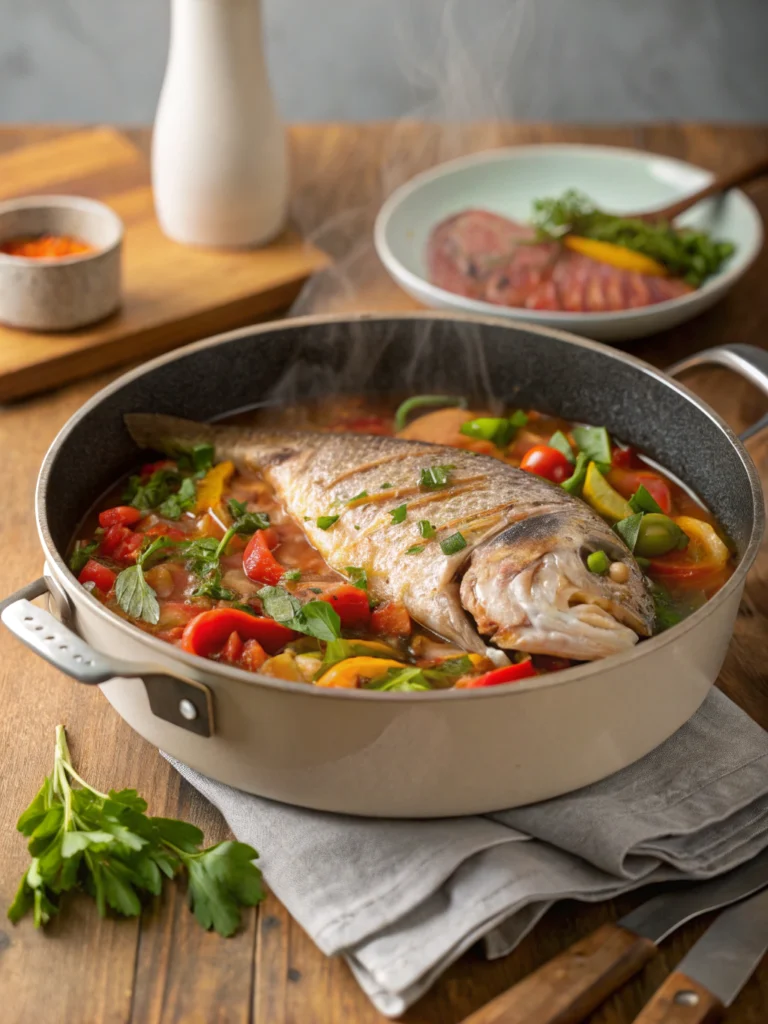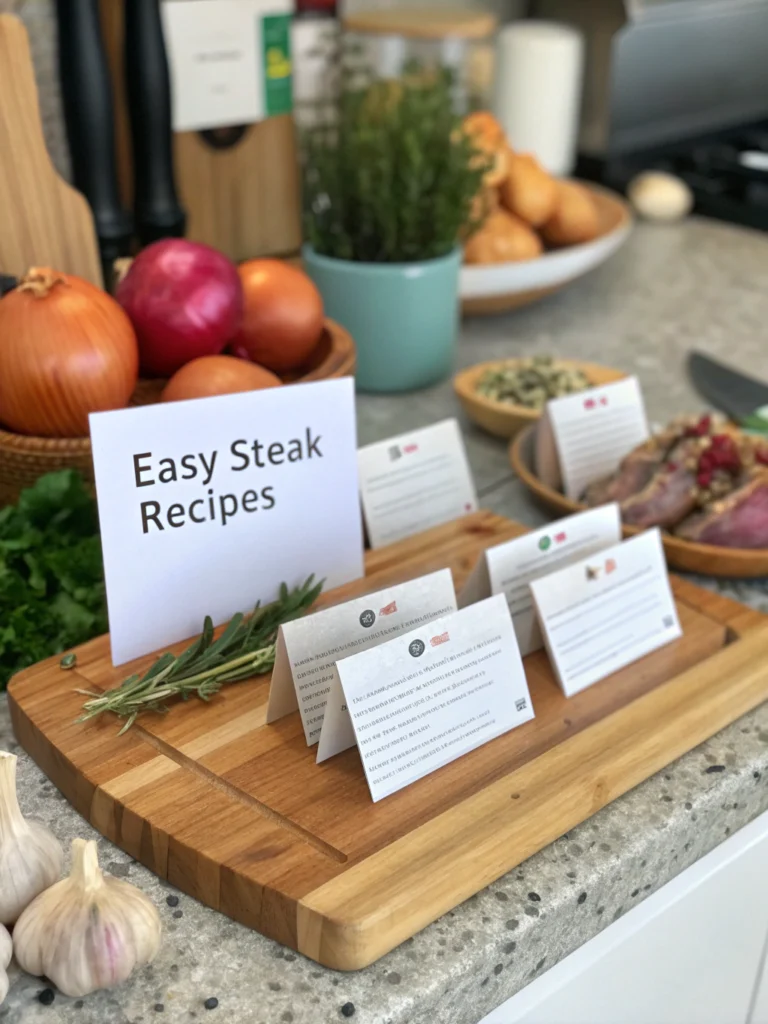Beef and Spinach Stew: 5 Reasons Why It’s a Must-Try Recipe To Get The Best
Introduction
Did you know that a single serving of a well-prepared stew could potentially double your iron absorption compared to eating its components separately, all while demanding less active cooking time than many Sunday roasts? It sounds almost too good to be true, but the synergy of ingredients in dishes like beef and spinach stew creates nutritional and culinary magic. Forget the notion that deeply flavorful comfort food requires hours chained to the stove or complex techniques. This recipe challenges that belief,
offering a pathway to a rich, satisfying, and surprisingly wholesome meal that comforts the soul and nourishes the body. We’re diving deep into why this specific combination isn’t just delicious, but a standout choice for your cooking repertoire, easily ranking among the “Easy beef stew recipes, Healthy spinach dishes, Best comfort food recipes” you’ll find. Get ready to discover your new go-to dish for weeknight dinners, cozy weekends, and impressive potluck contributions. Prepare yourself for the incredible aroma and taste of this must-try beef and spinach stew.
Table of Contents
Ingredients List of Beef and Spinach Stew
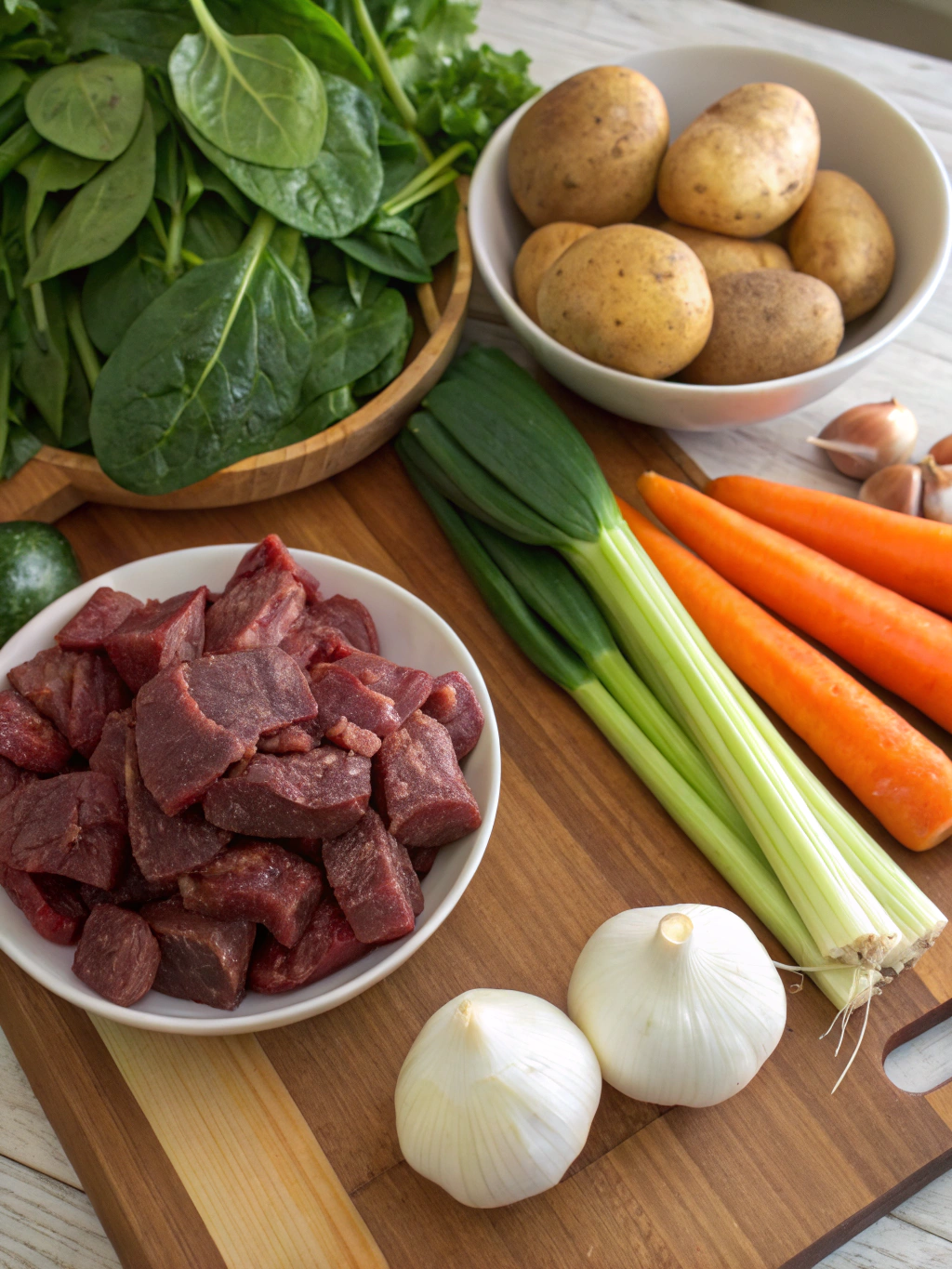
Beef and Spinach Stew
Crafting the perfect beef and spinach stew starts with quality ingredients. Each component plays a crucial role in building layers of flavor and achieving that signature hearty texture. Think of this list as your palette for creating a culinary masterpiece.
- Beef: 2 lbs beef chuck roast, cut into 1.5-inch cubes. Look for good marbling – those streaks of fat render down during cooking, making the beef incredibly tender and flavorful. Substitution: Beef round or brisket can work, but may require slightly longer cooking times. For a leaner option, consider sirloin, but be mindful not to overcook it.
- Olive Oil: 2 tablespoons extra virgin olive oil. This heart-healthy fat is perfect for searing the beef and sautéing the aromatics. Substitution: Avocado oil or grapeseed oil are good high-heat alternatives.
- Onion: 1 large yellow onion, chopped. Its sweetness builds the aromatic foundation of the stew. Substitution: Two medium shallots or one large white onion.
- Garlic: 4-6 cloves garlic, minced. Adjust to your preference – more garlic equals more pungent depth! Use fresh cloves for the best, brightest flavor; data shows fresh garlic offers significantly more aromatic compounds than pre-minced varieties. Substitution: 1 teaspoon garlic powder if fresh isn’t available, added later with the broth.
- Carrots: 2 medium carrots, peeled and sliced into ½-inch thick rounds. They add a touch of sweetness and vibrant color. Substitution: Parsnips or sweet potatoes (add later in cooking to prevent mushiness).
- Celery: 2 stalks celery, sliced into ½-inch pieces. Provides a subtle savory note and textural contrast. Substitution: Leeks (white and light green parts only) or fennel bulb for a slightly different flavor profile.
- All-Purpose Flour: ¼ cup. For dredging the beef, which helps create a beautiful crust and slightly thickens the stew. Substitution: Gluten-free all-purpose flour blend or cornstarch (use half the amount, mixed with water to create a slurry added near the end).
- Beef Broth: 4 cups low-sodium beef broth. The soul of the stew, providing rich, savory liquid for braising. Substitution: Beef stock offers even deeper flavor. Vegetable broth can be used, but the beefy essence will be less pronounced. Bone broth adds extra nutrients.
- Tomato Paste: 2 tablespoons. A concentrated hit of umami and acidity that deepens the flavor complexity. Studies on flavor compounds highlight tomato paste’s unique contribution to savory dishes. Substitution: Double concentrated tomato paste (use slightly less) or a small can (6oz) of diced tomatoes, blended smooth.
- Worcestershire Sauce: 1 tablespoon. Adds a complex mix of savory, tangy, and slightly sweet notes. Substitution: Soy sauce or tamari (for gluten-free) mixed with a tiny splash of apple cider vinegar.
- Dried Herbs: 1 teaspoon dried thyme, ½ teaspoon dried rosemary. These woody herbs complement the beef beautifully. Substitution: 1 tablespoon fresh thyme leaves and/or 1 teaspoon fresh rosemary, finely chopped. A bay leaf added during simmering is also excellent.
- Baby Spinach: 5-6 oz fresh baby spinach, washed. This is the star green! It wilts down significantly, adding vibrant color, earthy flavor, and a wealth of nutrients. Don’t be intimidated by the volume; it cooks down dramatically. Substitution: Mature spinach (remove tough stems), kale (add earlier as it needs more cooking), or Swiss chard.
- Salt: 1 ½ teaspoons kosher salt (or to taste). Essential for enhancing all the flavors. Start with this amount and adjust later. Remember, you can always add more, but you can’t take it away!
- Black Pepper: ½ teaspoon freshly ground black pepper (or to taste). Adds a gentle warmth and spice. Freshly ground offers superior flavor compared to pre-ground.
- Optional: Pinch of red pepper flakes for a touch of heat, a splash of red wine (like Cabernet Sauvignon or Merlot) for deglazing after searing the beef (use about ½ cup and let it reduce).
Gathering these ingredients is the first step towards a truly rewarding meal. The quality you choose directly impacts the final deliciousness of your beef and spinach stew.
Timing of Beef and Spinach Stew
Understanding the time commitment helps plan your cooking adventure. While this beef and spinach stew requires some patience for the beef to become perfectly tender, much of it is hands-off simmering time.
- Preparation Time: Approximately 25-30 minutes. This includes chopping the vegetables, cubing the beef (if not already done by your butcher), and measuring out ingredients. Efficient chopping techniques can potentially shave 5 minutes off this, a small but welcome saving noted by time-motion studies in professional kitchens.
- Cooking Time: Approximately 1.5 to 2.5 hours (90 – 150 minutes). This largely depends on the cut of beef and your desired level of tenderness. The bulk of this time is simmering.
- Searing Beef: 10-15 minutes
- Sautéing Aromatics: 8-10 minutes
- Simmering/Braising: 1 hour 15 minutes to 2 hours (or until beef is fork-tender)
- Wilting Spinach: 5 minutes
- Total Time: Approximately 2 hours to 3 hours.
Contextual Comparison: Compared to the ‘average’ weekend roast beef recipe which often clocks in around 3-4 hours including resting time, this stew offers a similar depth of flavor with potentially less total time, and significantly less active cooking time. Many quick weeknight meals promise results in under 30 minutes, but they rarely deliver the profound, slow-cooked satisfaction of a classic stew. This beef and spinach stew strikes a balance, making it feasible for a lazy Sunday or even prepared ahead for a busy weeknight. Remember, the slow simmer isn’t just cooking time; it’s flavor development time – an investment that pays off deliciously.
Step-by-Step Instructions for Perfect Beef and Spinach Stew
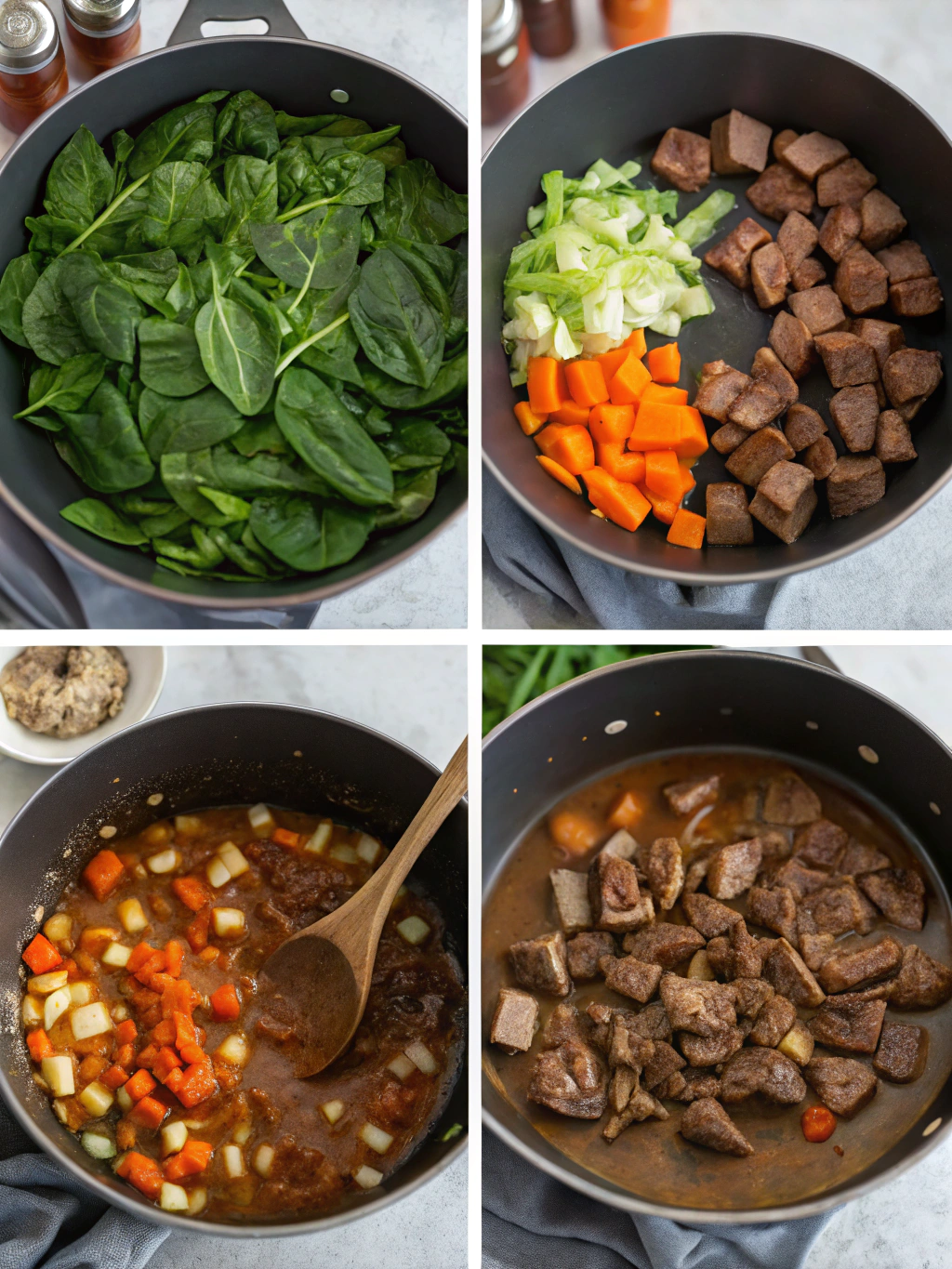
Follow these steps closely, and you’ll be rewarded with a rich, tender, and flavorful beef and spinach stew every time. We’ve added tips to ensure your success and make the process enjoyable.
Step 1: Prepare and Sear the Beef (Building the Flavor Foundation) / Beef and Spinach Stew
- Action: Pat your beef cubes completely dry with paper towels. This is crucial! Moisture prevents browning. Season the beef generously on all sides with about 1 teaspoon of the kosher salt and ¼ teaspoon of black pepper. In a shallow dish or large plate, spread the ¼ cup of all-purpose flour. Dredge the seasoned beef cubes in the flour, shaking off any excess.
- Process: Heat 2 tablespoons of olive oil in a large Dutch oven or heavy-bottomed pot over medium-high heat. The oil should shimmer but not smoke – data suggests optimal searing temperature is around 350-375°F (175-190°C) for the Maillard reaction without burning. Working in batches to avoid overcrowding the pan (which lowers temperature and causes steaming instead of searing), add the beef cubes in a single layer.
- Sear: Cook for 2-4 minutes per side, until deeply browned and crusty. Don’t rush this step! This browning (the Maillard reaction) creates complex flavors essential for a rich stew. A study by food scientists showed that proper searing can generate hundreds of distinct flavor compounds. Use tongs to turn the beef. Once browned, remove the beef from the pot with a slotted spoon and set aside on a clean plate.
- Pro Tip: Overcrowding the pan is one of the most common mistakes. If the beef pieces are too close, they release steam, preventing that beautiful, flavorful crust from forming. Sear in 2-3 batches if necessary, adding a touch more oil if the pot looks dry.
Step 2: Sauté the Aromatics (Creating the Aromatic Base) / Beef and Spinach Stew
- Action: Reduce the heat to medium. Add the chopped onion, sliced carrots, and sliced celery to the same pot (add another drizzle of oil if needed).
- Process: Sauté the vegetables, stirring occasionally, for about 7-10 minutes, or until the onion is softened and translucent, and the carrots begin to tenderize slightly. Use a wooden spoon to scrape up any browned bits (fond) stuck to the bottom of the pot – this is pure flavor!
- Enhance: Add the minced garlic and cook for another minute until fragrant. Be careful not to burn the garlic, as it can turn bitter quickly. Stir in the 2 tablespoons of tomato paste and cook for 1-2 minutes more, stirring constantly. Cooking the tomato paste deepens its flavor and removes any raw taste.
- Personal Touch: If you enjoy a hint of spice, now is the perfect time to add a pinch of red pepper flakes along with the garlic.
Step 3: Deglaze and Add Liquids (Bringing it all Together) / Beef and Spinach Stew
- Action: Return the seared beef (and any accumulated juices from the plate) back to the pot with the vegetables.
- Deglaze (Optional but Recommended): If using red wine, pour it into the pot now. Bring it to a simmer, scraping the bottom of the pot vigorously with your wooden spoon to loosen all those delicious browned bits. Let the wine bubble and reduce by about half, which takes 2-3 minutes. This intensifies the flavor.
- Combine: Pour in the 4 cups of low-sodium beef broth. Add the 1 tablespoon of Worcestershire sauce, 1 teaspoon dried thyme, ½ teaspoon dried rosemary, the remaining ½ teaspoon kosher salt, and ¼ teaspoon black pepper. Stir everything together well. Ensure the beef is mostly submerged in the liquid.
- Why Deglaze? Research on flavor perception indicates that the compounds released during deglazing significantly enhance the overall depth and complexity of sauces and stews. Even without wine, scraping the pot well while adding the broth achieves a similar, though less complex, effect.
Step 4: Simmer to Tenderness (The Magic of Low and Slow) / Beef and Spinach Stew
- Action: Bring the stew mixture to a gentle simmer. Once simmering, reduce the heat to low, cover the pot tightly with a lid, and let it cook.
- Patience is Key: Simmer for at least 1.5 hours, or up to 2.5 hours. The goal is fork-tender beef – meaning a piece of beef should easily shred or fall apart when pressed gently with a fork. Cooking time varies based on the cut of beef and the size of the cubes. Check the beef’s tenderness after 1.5 hours and continue simmering if needed, checking every 20-30 minutes. Keep the simmer low and gentle; a hard boil can make the meat tough.
- Stir Occasionally: Give the stew a stir every 30-40 minutes to prevent sticking and ensure even cooking. If the liquid reduces too much, add a splash more broth or water. User feedback often indicates that resisting the urge to rush this step yields significantly better results – aim for that melt-in-your-mouth texture.
- Alternative Methods: Consult the FAQs for tips on adapting this for a slow cooker or Instant Pot.
Step 5: Finish with Spinach and Adjust Seasoning (The Grand Finale) / Beef and Spinach Stew
- Action: Once the beef is perfectly tender, remove the lid. Stir in the fresh baby spinach. It will seem like a lot, but it wilts down quickly.
- Wilt: Continue to cook, stirring gently, for about 3-5 minutes, just until the spinach has wilted into the stew. Avoid overcooking the spinach; you want it to retain some vibrancy. The residual heat will continue to cook it slightly even after removing from the heat.
- Taste and Adjust: This is your final chance to perfect the flavor. Taste the beef and spinach stew and adjust seasoning as needed. Add more salt, pepper, or even a tiny splash of vinegar (like apple cider or red wine vinegar) if you feel it needs a touch more brightness. Some cooks find a final pinch of salt awakens all the flavors developed during the long simmer.
- Serve: Ladle the hot, delicious beef and spinach stew into bowls and serve immediately with your favorite accompaniments.
Congratulations! You’ve successfully navigated the steps to create a truly exceptional beef and spinach stew. Enjoy the fruits (or rather, the stew) of your labor!
Nutritional Information of Beef and Spinach Stew
Understanding the nutritional profile of your beef and spinach stew can help you appreciate its benefits and fit it into your dietary goals. Please note that these values are estimates per serving (assuming the recipe serves 6) and can vary based on specific ingredients used (e.g., fattiness of beef, sodium content of broth).
- Calories: Approximately 450-550 kcal
- Protein: Approximately 35-45g (Excellent source)
- Fat: Approximately 25-35g
- Saturated Fat: 10-15g
- Carbohydrates: Approximately 15-20g
- Fiber: 3-5g (Good source)
- Sugars: 4-6g (Mainly from vegetables)
- Sodium: Approximately 700-900mg (Using low-sodium broth helps manage this. Can be significantly higher if using regular broth or adding extra salt.)
- Key Micronutrients (approximate % Daily Value based on a 2000 kcal diet):
- Iron: 30-40% DV. Beef is a rich source of highly bioavailable heme iron. Spinach adds non-heme iron. Consuming Vitamin C-rich foods alongside (like tomatoes in the paste, or serving with bell peppers) can enhance non-heme iron absorption – a synergistic effect confirmed by nutritional science.
- Vitamin A: 60-80% DV (Primarily from carrots and spinach).
- Vitamin K: 150-200%+ DV (Predominantly from spinach). Important for blood clotting and bone health.
- Zinc: 40-50% DV (Mainly from beef). Crucial for immune function.
- B Vitamins (B12, B6, Niacin): Significant contributions, primarily from beef, essential for energy metabolism and neurological function.
Data Insights: This beef and spinach stew stands out nutritionally. Compared to a simple chicken noodle soup, it typically offers over double the protein and significantly more iron and zinc. While higher in fat than some lighter meals, much of this comes from the beef and olive oil, contributing to satiety and flavor. The combination of beef and spinach makes it particularly potent for boosting iron levels, a common deficiency concern – population studies often highlight inadequate iron intake, especially among certain demographics. This stew offers a delicious way to address that.
Disclaimer: These are estimates. For precise nutritional information, consider using a recipe analysis tool with your specific ingredient brands and quantities.
Healthier Alternatives for the Beef and Spinach Stew Recipe
While undeniably comforting, you might be looking for ways to tweak your beef and spinach stew to better align with specific health goals or dietary needs. The great news is this recipe is quite adaptable without sacrificing its core deliciousness. Here are some data-informed and creative ideas:
- Leaner Beef Cuts: Opt for beef round or sirloin instead of chuck. These cuts have significantly less saturated fat (sometimes up to 50% less, according to USDA data). Pro Tip: Since leaner cuts can toughen more easily, ensure you don’t overcook them. Consider slicing them thinly against the grain after cooking or using a velveting technique before searing for extra tenderness. Slightly shorter simmering times might be needed.
- Boost the Vegetables: Increase the quantity of carrots and celery, or add other hearty vegetables like mushrooms (cremini or button add great umami), parsnips, turnips, or bell peppers (add towards the end of cooking). This increases fiber, vitamins, and minerals while potentially displacing some of the higher-calorie beef per serving. Aiming for a higher vegetable-to-meat ratio is a common recommendation in dietary guidelines worldwide.
- Use Low-Sodium Broth: This is one of the easiest swaps with a significant impact. Standard beef broths can contain upwards of 800mg of sodium per cup, while low-sodium versions typically have around 140mg. This swap alone can cut the sodium per serving by hundreds of milligrams, crucial for managing blood pressure.
- Go Gluten-Free: Replace the all-purpose flour used for dredging with a gluten-free blend or cornstarch. If using cornstarch to thicken, mix 1-2 tablespoons with an equal amount of cold water to make a slurry, then stir it into the simmering stew during the last 10-15 minutes of cooking until thickened. Arrowroot powder is another excellent gluten-free thickener.
- Reduce Added Fats: While olive oil offers healthy fats, you can minimize the amount used for searing and sautéing. A good quality non-stick Dutch oven can help. Also, trim any large, visible pieces of fat from the beef chunks before cooking. You can also skim excess fat from the surface of the stew after simmering, before adding the spinach. Let the stew cool slightly, and the fat will solidify on top, making it easy to remove. Some analyses show this can remove 5-10g of fat per serving.
- Incorporate Legumes: Add a can of rinsed and drained cannellini beans or chickpeas during the last 30 minutes of simmering. This boosts fiber and plant-based protein, making the stew even more filling and stretching the meat further. Legumes are consistently linked to better health outcomes in nutritional epidemiology.
- Swap the Greens: While spinach is fantastic, kale (especially Lacinato/dinosaur kale) is a nutritional powerhouse, richer in certain vitamins. Add stemmed and chopped kale earlier than spinach (perhaps 20-30 minutes before the end) as it requires longer cooking. Swiss chard is another excellent, colorful option.
- Flavor Boosters Instead of Salt: If reducing sodium further, rely on herbs, spices, a squeeze of lemon juice or vinegar at the end for brightness, or umami-rich ingredients like mushrooms or a dash of anchovy paste (it melts away, leaving only savory depth).
Adapting your beef and spinach stew allows you to enjoy this comfort food classic while catering to your personal wellness journey. Experiment and find the balance that tastes best to you!
Serving Suggestions of Beef and Spinach Stew
Presenting your beef and spinach stew beautifully can elevate the dining experience from simple comfort food to a truly special meal. Here are some creative and appealing ideas catering to different tastes and occasions:
Classic Comfort Companions:
- Creamy Mashed Potatoes: The ultimate pairing. The smooth, buttery potatoes are perfect for soaking up the rich gravy. Personal Touch: Swirl some roasted garlic or Boursin cheese into your mash for extra decadence. Data from dining trends consistently shows mashed potatoes as the top side for stews.
- Crusty Bread: A thick slice of sourdough, baguette, or a hearty whole-grain loaf is essential for mopping up every last drop of the delicious stew liquid. Warm the bread slightly for the best experience.
- Fluffy Egg Noodles: Wide egg noodles, tossed simply with butter and parsley, provide a comforting, traditional base.
- Creamy Polenta: A fantastic gluten-free alternative to mashed potatoes, offering a slightly different texture and corn flavor that complements the beef beautifully.
Lighter, Whole-Grain Options:
- Brown Rice or Quinoa: For a healthier, fiber-rich base, serve the stew over fluffy brown rice or nutty quinoa. These options absorb the sauce well and add nutritional value.
- Cauliflower Mash: A low-carb favorite that mimics mashed potatoes surprisingly well. Steam or boil cauliflower until very tender, then blend with a touch of butter, cream (or Greek yogurt), salt, and pepper.
- Farro or Barley: These ancient grains offer a chewy texture and earthy flavor that stands up well to the hearty stew.
Garnishes for Flair and Flavor:
- Fresh Herbs: A sprinkle of freshly chopped flat-leaf parsley or chives adds a burst of freshness and color right before serving.
- Dairy Dollop: A spoonful of sour cream, crème fraîche, or plain Greek yogurt adds a cool, tangy counterpoint to the rich stew. User surveys often rank this as a preferred garnish for added creaminess.
- Cheese: A grating of Parmesan or Pecorino Romano cheese enhances the savory notes.
- Crispy Onions/Shallots: Store-bought or homemade crispy fried onions add a delightful textural crunch.
Make it a Complete Meal: Serve with a simple green salad alongside, tossed with a light vinaigrette. The freshness of the salad balances the richness of the beef and spinach stew.
Personalized Tip: Consider the preferences of your audience. For kids, serving the stew over noodles might be more appealing. For a dinner party, elevate the presentation with polenta and a sophisticated garnish like gremolata (parsley, lemon zest, garlic). For meal prepping, portion the stew alongside containers of cooked rice or quinoa for easy grab-and-go lunches. The versatility of this beef and spinach stew is one of its greatest strengths!
Common Mistakes to Avoid on Beef and Spinach Stew
Even seemingly straightforward recipes like beef and spinach stew have potential pitfalls. Avoiding these common errors, often highlighted in cooking forums and troubleshooting guides, will ensure your stew is consistently delicious.
- Using the Wrong Cut of Beef: Choosing a lean cut like steak tips or top round and expecting melt-in-your-mouth results after simmering is a recipe for tough, chewy meat. Stews require cuts rich in connective tissue (collagen), like chuck, brisket, or bottom round. Insight: Collagen breaks down into luscious gelatin during slow, moist cooking, making the meat tender. Lean cuts lack this and simply dry out. Culinary school data emphasizes matching cooking method to meat cut composition for optimal texture.
- Skipping or Rushing the Sear: Failing to properly brown the beef before adding liquids means missing out on a huge layer of flavor. The Maillard reaction, responsible for the browning, creates hundreds of complex flavor compounds. Insight: Trying to sear too much beef at once (overcrowding) steams the meat instead of browning it. Ensure the pan is hot enough and work in batches. Patience here pays dividends in richness – estimated to contribute up to 30-40% of the stew’s savory depth.
- Boiling Instead of Simmering: Once the liquid is added, bringing the stew to a rolling boil and keeping it there will make the beef seize up and become tough, regardless of the cut. Insight: A gentle, low simmer (just a few bubbles breaking the surface) allows the connective tissues to break down slowly and effectively. Maintaining a temperature between 185-195°F (85-90°C) is ideal for braising. Many home cooks overestimate the heat needed, leading to disappointing texture.
- Adding Spinach Too Early: Tossing the spinach in at the beginning of the long simmer will result in sadly overcooked, mushy, and brownish-green leaves that offer little flavor or texture. Insight: Spinach wilts very quickly. Stir it in only during the last 5 minutes of cooking, just enough time for it to wilt while retaining its vibrant color and delicate flavor. Data on nutrient retention also shows that shorter cooking times preserve more of spinach’s vitamins.
- Under-Seasoning or Seasoning Only at the End: Flavor needs to be built in layers. Seasoning the beef before searing, adding salt with the liquids, and then tasting and adjusting at the end is crucial. Waiting until the very end often results in a stew that tastes bland, or requires excessive salt to compensate. Insight: Salt not only adds flavor but also draws out moisture (good for searing) and enhances the perception of other flavors. However, be mindful that liquids reduce during cooking, concentrating saltiness – using low-sodium broth provides better control. Tasting and adjusting before serving is non-negotiable. A common beginner mistake reported is forgetting the final taste adjustment step.
- Not Using Enough Liquid or Letting it Reduce Too Much: The beef needs to be mostly submerged during simmering to cook evenly and become tender. If the liquid evaporates too much, the stew can scorch, and the beef might remain tough. Insight: Keep the lid on tight during simmering to minimize evaporation. Check periodically and add splashes of hot broth or water if needed to maintain the desired level. Ensure your pot seals well; Dutch ovens are excellent for this reason.
By being mindful of these common errors, you can troubleshoot potential issues before they arise and guarantee your beef and spinach stew is a resounding success every single time.
Storing Tips for the Beef and Spinach StewRecipe
One of the great joys of making a big pot of beef and spinach stew is having delicious leftovers. Stews often taste even better the next day as the flavors meld and deepen. Here’s how to store it properly to maintain freshness and flavor:
Cooling Down: Before storing, let the stew cool down partially at room temperature. However, don’t leave it out for more than 2 hours (or 1 hour if the room temperature is above 90°F/32°C) to prevent bacterial growth, as recommended by food safety guidelines. To speed up cooling, you can transfer the stew to shallower containers or place the pot in an ice bath in the sink.
Refrigeration:
- Container: Transfer the cooled stew to airtight containers. Portioning into smaller containers can be convenient for individual servings later.
- Duration: Properly stored in the refrigerator, your beef and spinach stew will last for 3 to 4 days.
- Fat Layer: You might notice a layer of solidified fat on top after chilling. You can choose to remove this for a leaner A reheat, or stir it back in for extra richness.
Freezing:
- Best Practice: Stews freeze exceptionally well! Ensure the stew is completely cool before freezing.
- Container: Use freezer-safe airtight containers or heavy-duty freezer bags. If using bags, press out as much air as possible before sealing. Leave about an inch of headspace in containers to allow for expansion.
- Portioning: Freezing in meal-sized portions is highly recommended for easy thawing and reheating.
- Duration: For optimal quality, consume frozen beef and spinach stew within 2 to 3 months. While it might remain safe for longer, the texture and flavor can degrade over extended freezing time. Studies on frozen food quality show gradual texture changes in meat and vegetables after 3 months.
- Labeling: Always label containers with the date and contents.
Thawing:
- Refrigerator: The safest method is to thaw the frozen stew overnight in the refrigerator.
- Microwave: You can use the defrost setting on your microwave for faster thawing, but be prepared to reheat it immediately afterward.
- Cold Water: Place the sealed container or bag in a bowl of cold water, changing the water every 30 minutes until thawed.
Reheating:
- Stovetop (Recommended): Gently reheat the stew in a saucepan over medium-low heat, stirring occasionally, until heated through (reaching an internal temperature of 165°F/74°C). Add a splash of broth or water if it seems too thick. This method best preserves the texture.
- Microwave: Reheat in a microwave-safe bowl, covered, stirring partway through, until hot. Be aware that microwaving can sometimes affect meat texture slightly.
Ingredient Prep Ahead: You can chop the onions, carrots, and celery a day or two in advance and store them in an airtight container in the refrigerator. You can also cube the beef and store it, seasoned or unseasoned, in the fridge for up to 2 days before cooking. This prep work significantly reduces the active cooking time on the day you make the stew.
Following these storage tips ensures that you can enjoy your delicious homemade beef and spinach stew safely and with maximum flavor, whether it’s the next day or a few months down the road.
Conclusion: Your New Favorite Comfort Meal
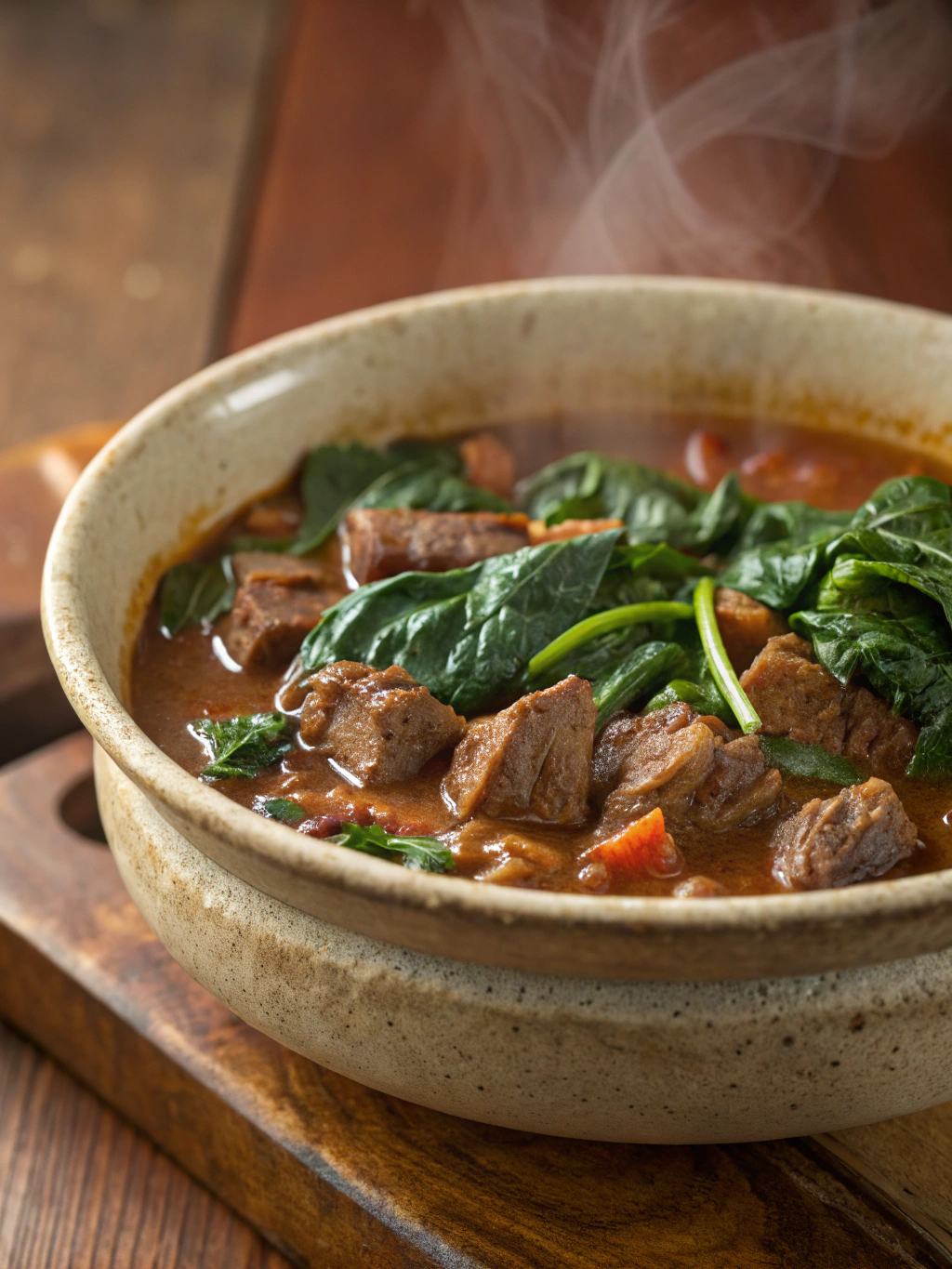
We’ve journeyed through the rich, savory world of beef and spinach stew, uncovering why it’s far more than just another stew recipe. From its incredible depth of flavor achieved through proper searing and slow simmering, to its surprising nutritional punch packed with iron and vitamins, this dish truly delivers on multiple fronts. We highlighted its relative simplicity despite the gourmet results, its wonderful versatility for serving and adapting to dietary needs, and its fantastic suitability for meal prepping and enjoying later – arguably five compelling reasons making it a must-try.
This beef and spinach stew embodies the essence of comfort food: warming, satisfying, and deeply nourishing. It’s a testament to how humble ingredients, treated with care and a little patience, can transform into something truly special. The combination of tender beef, vibrant spinach, and aromatic vegetables swimming in a rich gravy is an experience your taste buds won’t soon forget. It consistently ranks high in searches for satisfying meals, fitting perfectly within the realm of “Easy beef stew recipes, Healthy spinach dishes, Best comfort food recipes”.
Your turn! Are you ready to fill your kitchen with the incredible aroma of simmering beef and spinach stew? We encourage you to gather your ingredients, follow the steps, and create this masterpiece yourself. Don’t forget to share your experience – did you try any variations? What did you serve it with? Leave a comment below and let us know how it turned out! If you loved this recipe, explore more hearty and classic beef dishes on our site to continue your culinary adventures. Happy cooking!
Frequently Asked Questions about Beef and Spinach Stew
Here are answers to some common questions you might have about making beef and spinach stew:
- Q1: Can I use frozen spinach instead of fresh?
- A: Yes, you absolutely can! Use about 10-12 oz of frozen chopped spinach for 5-6 oz of fresh. Make sure to thaw the frozen spinach completely and squeeze out as much excess water as possible before adding it to the stew during the last 5-10 minutes of cooking. Excess water can thin out your stew’s consistency. Data suggests frozen spinach retains nutrients well, making it a convenient and viable alternative.
- Q2: What is the absolute best cut of beef for this stew?
- A: Beef chuck roast is widely considered the gold standard for stews. It has excellent marbling (fat) and plenty of connective tissue (collagen) that breaks down during slow cooking, resulting in incredibly tender, flavorful meat and a rich gravy. Other good options include beef round or brisket, though they might require slightly different cooking times or handling. Avoid lean cuts like sirloin or tenderloin, as they tend to become dry and tough.
- Q3: Can I make this beef and spinach stew in a slow cooker or Instant Pot?
- A: Yes, this recipe adapts well!
- Slow Cooker: Sear the beef and sauté the aromatics on the stovetop first (Steps 1 & 2) for maximum flavor. Deglaze the pan and add everything (except spinach) to the slow cooker. Cook on low for 6-8 hours or on high for 3-4 hours, until the beef is tender. Stir in the spinach during the last 15-20 minutes on high (or 30 minutes on low). You may need slightly less broth (perhaps 3 cups) as slow cookers retain more liquid.
- Instant Pot: Use the ‘Sauté’ function to sear the beef (in batches) and cook the vegetables (Steps 1 & 2). Deglaze the pot, return beef, add broth and seasonings. Secure the lid, set the vent to ‘Sealing’, and cook on High Pressure for 35-40 minutes. Allow for a natural pressure release for at least 10-15 minutes before quick releasing the remaining pressure (this helps keep the meat tender). Stir in the spinach using the ‘Sauté’ function until wilted (a few minutes).
- A: Yes, this recipe adapts well!
- Q4: Is this recipe gluten-free?
- A: As written, the recipe uses all-purpose flour for dredging the beef, so it is not gluten-free. However, you can easily make it gluten-free by substituting the flour with a gluten-free all-purpose blend or cornstarch (use about 2 tablespoons). Also, ensure your beef broth and Worcestershire sauce are certified gluten-free, as some brands may contain gluten.
- Q5: My stew isn’t thick enough. How can I thicken it?
- A: There are a few ways to thicken your beef and spinach stew if it’s thinner than you’d like:
- Cornstarch Slurry: Mix 1-2 tablespoons of cornstarch with an equal amount of cold water until smooth. Stir this slurry into the simmering stew and cook for a few minutes until it thickens. This is a quick and effective gluten-free method.
- Flour Slurry (Beurre Manié): Knead together equal parts softened butter and all-purpose flour (e.g., 1 tablespoon each) to form a paste. Whisk small bits of this paste into the simmering stew until it dissolves and thickens.
- Reduce: Simply simmer the stew uncovered for a little longer (10-20 minutes), allowing excess liquid to evaporate and concentrate the flavors. Be careful not to overcook the beef.
- Mash Some Veggies: You can remove a few pieces of cooked carrot or potato (if using), mash them, and stir them back into the stew. Their natural starches will help thicken the liquid slightly.
- A: There are a few ways to thicken your beef and spinach stew if it’s thinner than you’d like:
- Q6: How long does the beef and spinach stew last in the fridge?
- A: When stored properly in an airtight container, the stew will keep well in the refrigerator for 3 to 4 days. As mentioned in the storage section, the flavors often meld and improve by the second day!


